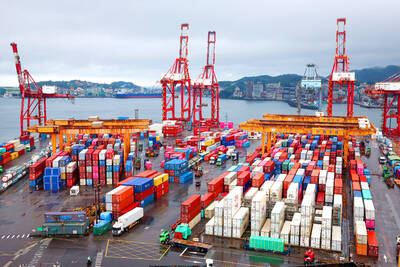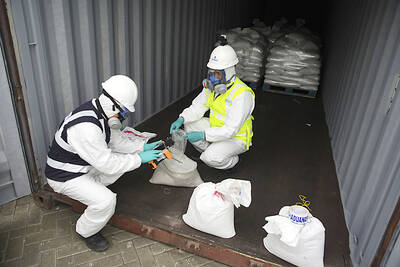Thousands of people on Saturday protested in Spain’s Balearic Islands against mass tourism ahead of the summer travel season.
Holding posters reading “SOS Residents” and “Enough Mass Tourism,” protesters marched through Palma, the capital of the largest Balearic Island, Mallorca.
About 10,000 demonstrators took part, a Spanish National Police spokesperson said.

Photo: Reuters
A smaller protest with a few hundred people was staged in Menorca.
“We want the authorities to stop people who have not lived here more than five years from buying properties and to put more controls on holiday accommodation,” said Carme Reines, from a collective that organized the protest in Palma.
Real-estate agent Javier Carbonell said more than half of rental properties were used for holiday rents and were not affordable for locals.
“We want less mass tourism and more sustainable tourism,” Carbonell said.
After Catalonia, the Balearic Islands was the second-most popular region of Spain for tourists last year, attracting 14.4 million people, the Spanish National Statistics Institute said.
About 18 million tourists visited Catalonia and 13.9 million people visited the Canary Islands.
Tourism generates 45 percent of the Balearic Islands’ GDP, data from industry organization Exceltur showed.
On Friday, about 1,000 protesters took part in a demonstration against mass tourism in Ibiza, one of the most popular Balearic Islands.
“We want a limit on new tourist places and a ban on more illegal flats. With less flats around on the market, it pushes up the price,” said Rafael Gimenez, a spokesman for Prou Ibiza, which organized Friday’s protest.
Last month, thousands of people protested in the Canary Islands, calling for a temporary limit on tourist arrivals to stem a boom in short-term holiday rentals and hotel construction that is increasing housing costs for locals.

SMART MANUFACTURING: The company aims to have its production close to the market end, but attracting investment is still a challenge, the firm’s president said Delta Electronics Inc (台達電) yesterday said its long-term global production plan would stay unchanged amid geopolitical and tariff policy uncertainties, citing its diversified global deployment. With operations in Taiwan, Thailand, China, India, Europe and the US, Delta follows a “produce at the market end” strategy and bases its production on customer demand, with major site plans unchanged, Delta president Simon Chang (張訓海) said on the sidelines of a company event yesterday. Thailand would remain Delta’s second headquarters, as stated in its first-quarter earnings conference, with its plant there adopting a full smart manufacturing system, Chang said. Thailand is the firm’s second-largest overseas

‘REMARKABLE SHOWING’: The economy likely grew 5 percent in the first half of the year, although it would likely taper off significantly, TIER economist Gordon Sun said The Taiwan Institute of Economic Research (TIER) yesterday raised Taiwan’s GDP growth forecast for this year to 3.02 percent, citing robust export-driven expansion in the first half that is likely to give way to a notable slowdown later in the year as the front-loading of global shipments fades. The revised projection marks an upward adjustment of 0.11 percentage points from April’s estimate, driven by a surge in exports and corporate inventory buildup ahead of possible US tariff hikes, TIER economist Gordon Sun (孫明德) told a news conference in Taipei. Taiwan’s economy likely grew more than 5 percent in the first six months

SUPPLY RESILIENCE: The extra expense would be worth it, as the US firm is diversifying chip sourcing to avert disruptions similar to the one during the pandemic, the CEO said Advanced Micro Devices Inc (AMD) chief executive officer Lisa Su (蘇姿丰) on Wednesday said that the chips her company gets from supplier Taiwan Semiconductor Manufacturing Co (TSMC, 台積電) would cost more when they are produced in TSMC’s Arizona facilities. Compared with similar parts from factories in Taiwan, the US chips would be “more than 5 percent, but less than 20 percent” in terms of higher costs, she said at an artificial intelligence (AI) event in Washington. AMD expects its first chips from TSMC’s Arizona facilities by the end of the year, Su said. The extra expense is worth it, because the company is

The seizure of one of the largest known mercury shipments in history, moving from mines in Mexico to illegal Amazon gold mining zones, exposes the wide use of the toxic metal in the rainforest, according to authorities. Peru’s customs agency, SUNAT, found 4 tonnes of illegal mercury in Lima’s port district of Callao, according to a report by the non-profit Environmental Investigations Agency (EIA). “This SUNAT intervention has prevented this chemical from having a serious impact on people’s health and the environment, as can be seen in several areas of the country devastated by the illegal use of mercury and illicit activities,”